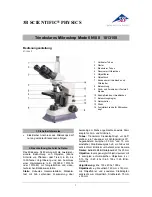
2
1.
Changing Magnification
a.
Magnification is changed by rotating the nosepiece until a different lens is moved into the
optical path. Always turn the turret until you hear it “click”. This indicates that the lens is
properly
positioned.
b.
The standard lenses that are provided with your microscope are a widefield 10x eyepiece
(HS1+1, HS-1D Models come with 2 separate eyetubes as well as 2 eyepieces). 4x, 10x and
40x objectives. The 40x objective has a special spring retractable mechanism which
retracts slightly when front of lens comes in contact with the specimen slide. See chart
below for specifications on objectives:
OBJECTIVE SPECIFICATION CHART
c.
Also note that each objective has a color ring. This allows you to quickly change in
magnification by referring to an easily observed color rather than to a number.
d.
The microscope has been parfocalled at the factory, which allows the user to easily change
from one magnification to another requiring little or no adjustment of the fine focus
knobs.
e.
As you increase the magnification, the field of view (area of specimen seen through the
microscope) will decrease. That is why it is easier to find the specific area of interest on the
specimen by starting with the lowest 4x objective lens , before increasing magnification
with the 10x or 40x objective lens.
f.
NOTE:
Care must be taken when rotating the 40x objective lens into place. This lens has
a spring retractable mechanism which retracts slightly into its housing if the front of the
lens strikes the specimen slide. With fine focus adjustment at mid-range, the rack stop has
been adjusted at the factory to assure the 40x lens will clear the thickness of a normal
specimen slide and cover slip. However, if the rack stop has been improperly adjusted, or
if you are using a thicker than 0.17mm cover slip, moving the 40x lens too quickly could
cause damage to the front lens element or to the slide.
Objective
N.A.
Color Code
Ring
Field of View
Working
Distance
Mag with
WF10x Eyepiece
Din 4x
Din 10x
Din 40x
retractable
0.10
0.25
0.65
Red
Yellow
Blue
4.5mm
1.8mm
0.45mm
18.5mm
6.4mm
0.5mm
40x
100x
400x
























